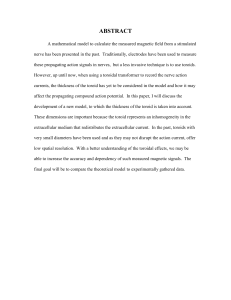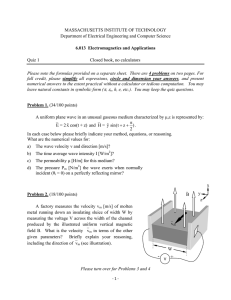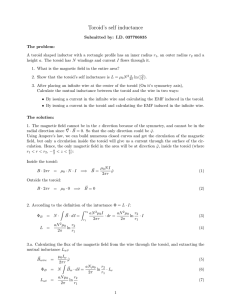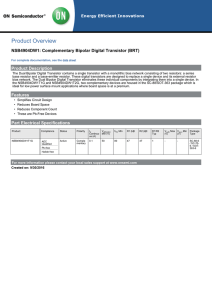Email comments, suggestions or requests to: willem
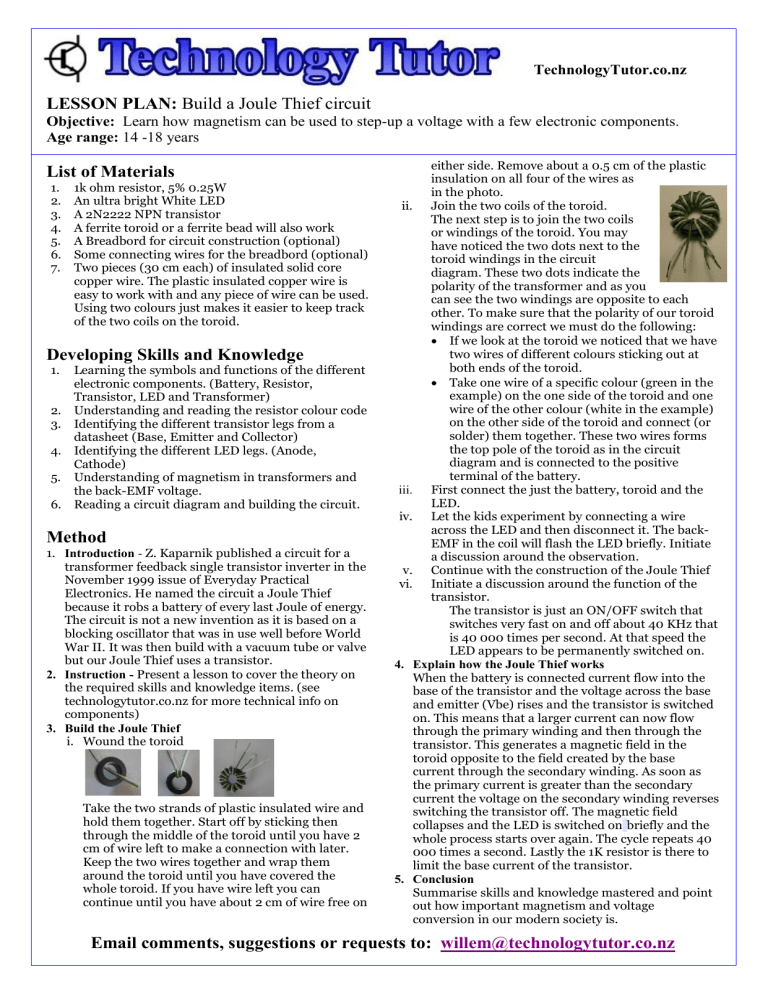
TechnologyTutor.co.nz
LESSON PLAN: Build a Joule Thief circuit
Objective: Learn how magnetism can be used to step-up a voltage with a few electronic components.
Age range: 14 -18 years
List of Materials
1. 1k ohm resistor, 5% 0.25W
2. An ultra bright White LED
3. A 2N2222 NPN transistor
4. A ferrite toroid or a ferrite bead will also work
5. A Breadbord for circuit construction (optional)
6. Some connecting wires for the breadbord (optional)
7. Two pieces (30 cm each) of insulated solid core copper wire. The plastic insulated copper wire is easy to work with and any piece of wire can be used.
Using two colours just makes it easier to keep track of the two coils on the toroid.
Developing Skills and Knowledge
1. Learning the symbols and functions of the different electronic components. (Battery, Resistor,
Transistor, LED and Transformer)
2. Understanding and reading the resistor colour code
3. Identifying the different transistor legs from a datasheet (Base, Emitter and Collector)
4. Identifying the different LED legs. (Anode,
Cathode)
5. Understanding of magnetism in transformers and the back-EMF voltage.
6. Reading a circuit diagram and building the circuit.
Method
1.
Introduction Z. Kaparnik published a circuit for a transformer feedback single transistor inverter in the
November 1999 issue of Everyday Practical
Electronics. He named the circuit a Joule Thief because it robs a battery of every last Joule of energy.
The circuit is not a new invention as it is based on a blocking oscillator that was in use well before World
War II. It was then build with a vacuum tube or valve but our Joule Thief uses a transistor.
2. Instruction Present a lesson to cover the theory on the required skills and knowledge items. (see technologytutor.co.nz for more technical info on components)
3. Build the Joule Thief i. Wound the toroid
Take the two strands of plastic insulated wire and hold them together. Start off by sticking then through the middle of the toroid until you have 2 cm of wire left to make a connection with later.
Keep the two wires together and wrap them around the toroid until you have covered the whole toroid. If you have wire left you can continue until you have about 2 cm of wire free on either side. Remove about a 0.5 cm of the plastic insulation on all four of the wires as in the photo.
ii.
Join the two coils of the toroid.
The next step is to join the two coils or windings of the toroid. You may have noticed the two dots next to the toroid windings in the circuit diagram. These two dots indicate the polarity of the transformer and as you can see the two windings are opposite to each other. To make sure that the polarity of our toroid windings are correct we must do the following:
If we look at the toroid we noticed that we have two wires of different colours sticking out at both ends of the toroid.
Take one wire of a specific colour (green in the example) on the one side of the toroid and one wire of the other colour (white in the example) on the other side of the toroid and connect (or solder) them together. These two wires forms the top pole of the toroid as in the circuit diagram and is connected to the positive terminal of the battery.
iii.
First connect the just the battery, toroid and the
LED.
iv.
Let the kids experiment by connecting a wire across the LED and then disconnect it. The back-
EMF in the coil will flash the LED briefly. Initiate a discussion around the observation.
v.
Continue with the construction of the Joule Thief vi.
Initiate a discussion around the function of the transistor.
The transistor is just an ON/OFF switch that switches very fast on and off about 40 KHz that is 40 000 times per second. At that speed the
LED appears to be permanently switched on.
4. Explain how the Joule Thief works
When the battery is connected current flow into the base of the transistor and the voltage across the base and emitter (Vbe) rises and the transistor is switched on. This means that a larger current can now flow through the primary winding and then through the transistor. This generates a magnetic field in the toroid opposite to the field created by the base current through the secondary winding. As soon as the primary current is greater than the secondary current the voltage on the secondary winding reverses switching the transistor off. The magnetic field collapses and the LED is switched on briefly and the whole process starts over again. The cycle repeats 40
000 times a second. Lastly the 1K resistor is there to limit the base current of the transistor.
5. Conclusion
Summarise skills and knowledge mastered and point out how important magnetism and voltage conversion in our modern society is.
